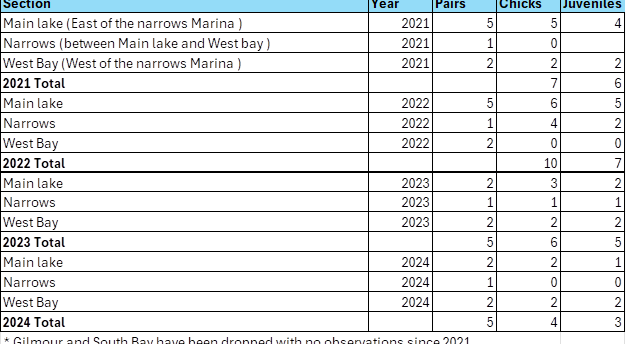Photo: Anita Spence
Wildlife
Amphibians
Birds

Photo: Wendy Turk
It is so disappointing the 2024 count is half of the historical average of 6 surviving chicks.
The spring count of breeding pairs seemed promising.
There were no reports of eggs lost to predators or high waters.

How can you help?
Provide shelter along the shoreline. Leave or add native wetland vegetation along your shoreline, as well as a border of unmown, untrimmed vegetation above the water’s edge. Loons rely on these sheltered areas when they are nesting, and to shelter their chicks. More importantly, natural shorelines and shallows are important breeding habitat and shelter for loons’ main food source: fish.
Dispose of garbage correctly. Making sure old docks, plastics, fishing line, and tackle are properly stored and disposed of prevents loons and other wildlife (e.g., turtles, waterbirds) from becoming seriously injured or entangled. Keeping food scraps contained avoids attracting nest scavengers that prey on eggs and chicks.
That calm winter storage for your dock at the end of a quiet bay or beside an island may be a potential nest location. Please remove those docks ASAP, ideally by early June.
USE NON-TOXIC, NON-LEAD FISHING TACKLE to prevent lethal ingestion of lead by loons. They may catch a hooked fish or mistake lost weights for pebbles that loons pick up to aid in their digestion.
SLOW DOWN and minimize boat wakes to avoid washing out loon nests on the shoreline.
STAY WELL BACK from the young hatchlings who are vulnerable, especially during their first few days of life. Rearing up, vocalizing, flattening the body, or coming off the nest are signs that a loon has been disturbed. If you notice any of these signs, move back.
The 40-year report, from CANADIAN LAKES (CLLS)LOON SURVEY which can be found on CLPOA.ca under Wildlife/birds lists the following as potential problems. More details on the causes and so much more can be found in the source document.
Human Disturbance
Shoreline development and boats pose important challenges for Common Loons. Loons build their nests along shorelines, just above the water level, so they have easy swimming access. They are particularly fond of small, isolated islands for nesting, which helps them avoid mammalian predators. As a result, shoreline development often degrades or eliminates loon nest sites. Development can also increase the abundance of predators, such as raccoons that eat eggs, and gulls that eat mostly chicks. Boating can lower productivity by creating wakes that wash out nests, disrupt adults while they are incubating eggs, or distract adults as they feed and protect their chicks. Boat collisions are also a significant source of mortality for loon adults and chicks.
It is therefore surprising that CLLS data show no relationship between loon productivity and shoreline development or boating activity. This is probably because most territorial loon pairs chose to avoid heavily disturbed and developed areas. It is important to realize that high levels of these factors can significantly reduce the number of territorial pairs in many locations.
Warming Temperatures
Data shows that there are fewer young per pair in years with cooler April temperatures and more young per pair in year with warmer April temperatures. Warming temperatures throughout the whole year may be reducing productivity.
Black Flies
Simulism annulus have a strong preference for Common Loon blood, feeding almost exclusively on loons while they are incubating their eggs. In years with high black fly numbers, loons are harassed so much they abandon their nests at higher rates.
Eagles and Cormorants
Data show that lakes with these birds provide a better breeding habitat for loons than those without. Probably due to a healthy fish population which also benefits the loon.
Acid Rain
Data shows that loon productivity is lower and declines in productivity are steeper over time on more acidic lakes. High acidity also increases the amount of mercury in the food chain, putting loons are greater risk.
Mercury
Adult loons with higher levels of mercury in their bodies are more lethargic and spend less time defending territories, incubating eggs and feeding chicks. Loon productivity is lower in loon with higher levels of mercury in their bodies.
There is no recent data for Mercury Levels on Chandos Lake. CLPOA is still looking for a local lab able to do the testing.
Climate Change Impacts
Could worsen the problems that acid rain and mercury pose for loons by intensifying changes in water temperatures.
Measuring Productivity
In loons, productivity is typically measured as the number of six-week-old young per pair per year. Six-week-old loons are about two-thirds the size of an adult loon, which means they have a much lower chance of being eaten by a predator, compared to younger chicks. Therefore, the number of six-week-old young per pair is a reliable indicator of the number of loon chicks that survive to adulthood.
Measuring loon productivity predicts future changes in the number of adult loons. A minimum of 0.48 six-week-old young per pair per year on average is needed to maintain stable numbers of adult loons. If loon productivity drops below this rate, then loon populations could start to decline.
Are Loons in Trouble? (As of CLLS study from 21 Aug, 2021)
The short answer is yes: Common Loons appear to be in trouble in Canada due to the declining trends in productivity shown by CLLS data. Luckily, however, there is still a large Canadian breeding population of at least an estimated 240,000 pairs. As well, CLLS data from across Canada show that loons currently produce about 0.55 young per pair per year on average, still above the 0.48 minimum required for a stable population. Nevertheless, if productivity declines below this threshold, which is currently where it appears to be headed, then the Canadian population will start to fall apart.
We are all very fortunate to have so many dedicated Chandos Lake volunteers. Many thanks to all of you who sent in your loon observations this year.
Please continue to do so in 2025. It may be of interest to CLLS those nesting sites that are no longer used, such as Donna Bay, Doc Island or opposite Island View trail and Lois Lane.
Sources:
https://www.birdscanada.org/bird-science/%20canadian-lakes- loon-survey
https://www.birdscanada.org/the-most-effective-ways-to-help-loons-this- summer
Fish

Photo: Benjamin Kostiuk
Chandos Lake is located in Zone 15 (Muskoka) Region, Peterborough & the Kawarthas.
Coordinates: 44.807559, -77.990415
Area: 1660.2 ha | 4102 ac | 16.6 km²
Chandos Lake Regulations:
- Fish sanctuary – No fishing from Jan. 1 – Fri. before 3rd Sat. in May, and Dec. 1 – Dec. 31.
- Lake Trout – None between 40-55 cm (15.7-21.7 in.)
- The close date for Largemouth & Smallmouth Bass is Jan. 1 to the Friday before the 4th Saturday in June (CLPOA Note: That’s June 21 & 22 respectively in 2019) and Dec. 1 – 31.
Reference: Ontario Fishing Regulations Zone 15 Parry Sound, Bancroft, Pembroke, Algonquin Park
- Anglers Atlas – Chandos Lake
- Canada’s National Fishing Week
- Fish of Ontario
- Ministry of Natural Resources and Forestry (MNRF) – Chandos Lake data
- Ontario Family Fishing
- Ontario Federation of Anglers & Hunters
- Ontario Ministry of Natural Resources & Forestry – everything you need to know before fishing in Ontario.
Insects
Mammals

On Jan 25 2024 this pack of animals was spotted on the Chandos Ice. They could be eastern wolves, coyotes or coywolves all of which belong to the Canid family.
According to the experts a proper identification requires DNA analyses.
Many of the links below were provided by the MNR Bancroft office explaining what to do if you encounter one, and more details on these Canids.
- Ontario Mammals
- inaturalist observation
- inaturalist not accept Coywolf ID
- Trent university news
- Management Preventing and managing conflicts with coyotes
- Coyote-proofing your property
- Encounters with coyotes
- Protecting your property
- Best practices guide: Coyote-human interactions
- Eastern Wolf
- CLPOA Facebook Group Post
- If it is Ontario it is a Coywolf






